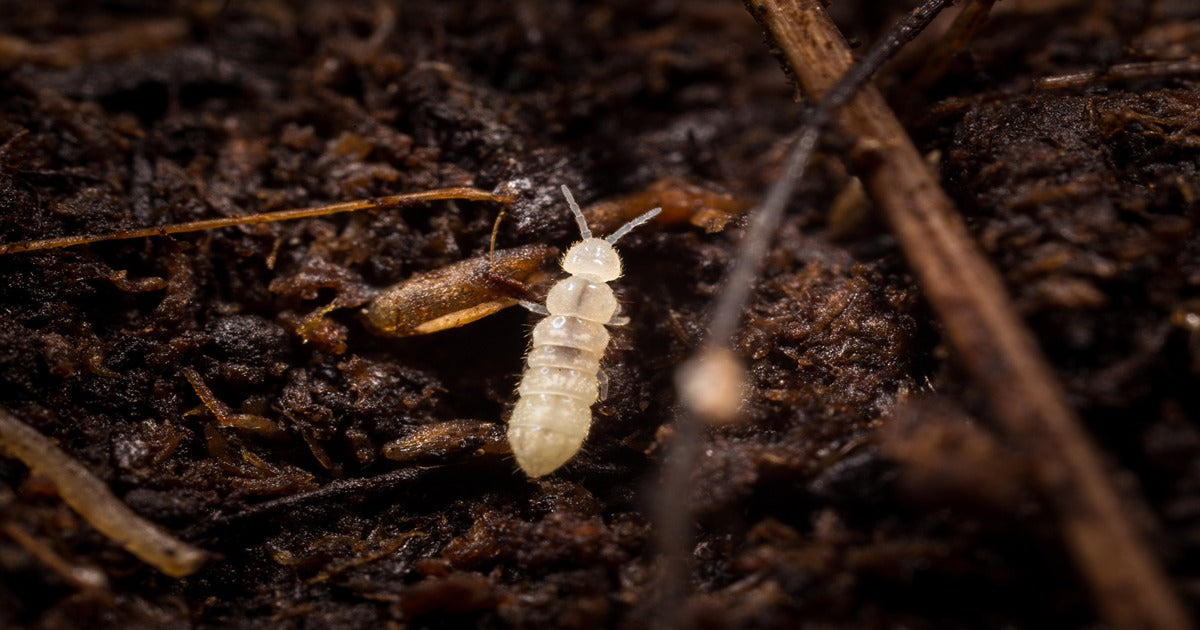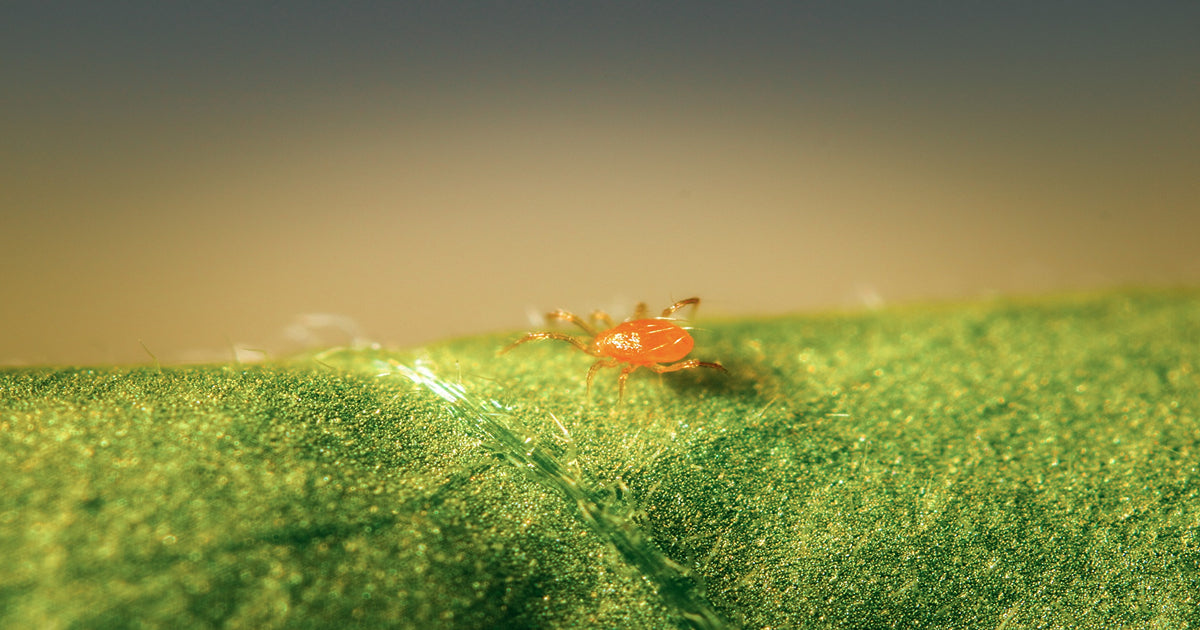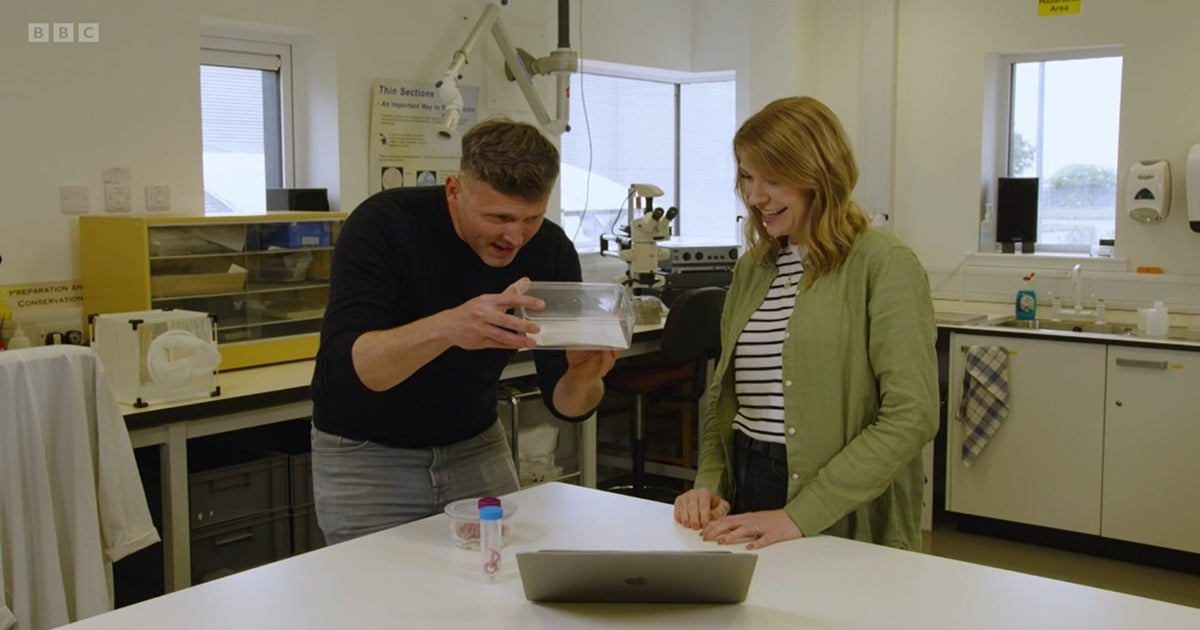
What Are Springtails?
Springtails (Collembola) commonly occur in soil and compost. They are not actually classed as an insect anymore, being more closely linked to Crustaceans. There are two commonly occurring species, one that lives underground, and one that lives on the soil or compost surface. The species that dwell under the surface tend to be white, while the surface populations can be green to dark brown.
When on the surface Springtails can jump up when threatened or disturbed. The switch to peat free compost has led to many composts being very rich in organic matter. This is ideal for the development of springtails, which can reach very high numbers.

Springtails are not classed as insects but as Crustaceans. A diverse family of animals that include Krill, Lobsters & Woodlice.
Springtails Break Down Organic Matter But Can Harm Plants If Present In Large Numbers
Springtails feed largely on organic matter, so when they are situated in a compost heap, or amongst leaf litter, they actually help with the breakdown of organic waste such as leaves.
In large numbers, however, they can feed on plant roots. In severe cases this can cause young seedlings and plants not to develop, or to die. Springtails enjoy wet conditions and thrive when lots of organic fertiliser is present.

Springtails will feed on organic matter and can aid in the breakdown of organic waste. In large numbers, however, they also present a danger to plants as they feed on plant roots.
How To Deal With Springtails
If Springtails are found in low numbers, or present in compost heaps, it is best to leave them alone and tolerate their presence. In high numbers, especially in growing media, you will need to take some action.
Try not to overwater your plants, or soil, as this provides an ideal environment for Springtails to populate, and try not to over feed with fertiliser. Some soil borne predatory mites will feed on Springtails including our very own Hypoaspis and Macrocheles (Mighty Mite) predators.

Dragonfli natural predators, such as the Macrocheles robustulus (Mighty Mite) can be used to control large populations of Springtails.
Apply either of these predators to the soil or surface of the compost. These predatory mites will feed on the eggs or young stages of the Springtail life cycle. They will also feed on other pests they locate in the compost such as Fungus Fly larvae and Thrip pupae. This makes the predators a good investment for protecting young plants, especially at the propagation stage.


You can purchase our Hypoaspis miles & Mighty Mite predators from the new dedicated Springtail Pest Page by clicking here.
Comments (5 Responses)
Julian Ives
Hi Scarlett,
Thanks for getting in touch.
Our Taurrus Snake Mite Predators may consume Springtail eggs. We also cannot say with absolute assurance that the Taurrus mites would not eat Springtail larvae as no trials have been conducted, as of yet, with regards to the relationship between the two species. Springtail adults would be too big for the Taurrus mites to predate though.
Sorry that I cannot offer any further information with regards to this. If you need any additional assistance or information on pests and predators, however, please do not hesitate to reach out to us again.
Kind regards, Julian Ives [Director, Dragonfli]
Scarlett
Was wondering if taurrus mites eat springtails
Julian Ives
Hi Steve, thanks for getting in touch.
Springtails can be difficult to control when they get to high numbers. Both our soil borne predatory mites, Hypoaspis and Macrocheles (Mighty Mite), are worth trying. However, maybe go with Mighty Mite this time, as I find it is slightly more aggressive, and more likely to take on larger prey than the Hypoaspis would.
The compost needs to be moist and of an open structure to ensure the predators become established. The application rate is between 100-500 predators per square metre, and applied to the compost surface where possible, so over the trays or pots.
The Mighty Mite need a minimum temperature of 15.c and I think this might be where your problem is with unheated poly tunnels early in the year, as it might not have been warm enough initially. When temperatures are warm enough one application should suffice, but it could be in your case that several applications are required. Try to not keep the compost too moist prior to the application, as this can encourage Springtail development.
Hope this all helps but if you both need any further advice feel free to get in touch via email at sales@dragonfli.co.uk, via social media, or by giving us a call on 01376 563322, and we’d be happy to assist.
Kind regards, Julian Ives [Director, Dragonfli]
Steve Abell
I am a wholesale grower of herbaceous perennials and grasses in 9cm pots, using peat free compost in unheated polytunnels. I have major problem with Springtails attacking roots of crops.
Please could you advice on temperature and conditions necessary for best results with Macrocheles and a programme for control.
I am raising plants in plug trays from seed.
I have used Hypoaspis for Sciarid last year but still have serious Springtail infestations.
Many thanks





04 October, 2024
Damon
OK so after reading the comments here and many other places, I grow indoors I have a springtail problem all round my house, they don’t bother me much except for my plants, the best way I’ve found to kill them pretty much instantly and also detere them is a strong mix of hydrogen peroxide and peppermint with water, you can spray it direct on them and watch them die in front of your eyes, if you’re watering outside obviously flood the place so make sure you don’t make the mix so strong as to damage the plants, whilst the peppermint world as a repellent don’t forget if you’ve got an infestation eggs will be born a few days after first treatment so treat for a fortnight if you catch the infestation early and 3 or 4 if its bad. Personal method that I’ve never seen anywhere , closest info I’ve seen is that oxygenated bleach kills them instantly, no good for plants obviously, believe me or don’t , but you’ve nothing to lose h2o2 is Good for plants and peppermint doesn’t harm them at all